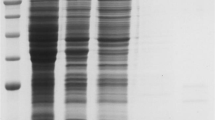Abstract.
The histone-like DNA-binding proteins (HU) are a convenient model for studying factors affecting thermostability because of their relatively simple, easily comparable structures, their common function, and their presence in organisms of widely differing thermostability. We report the determination of the high-resolution structure (1.53 Å) at 273 K and 100 K of the HU protein from the hyper-thermophilic eubacterium Thermotoga maritima (HUTmar, T m=80.5 °C). The structural data presented clearly show that the HUTmar has a fold similar to its thermophilic homologue HU from Bacillus stearothermophilus (HUBst). Based on primary structure analysis, as well as on the results of mutational analysis of HUBst (T m=61.6 °C) and Bacillus subtilis (HUBsu, T m=39.7 °C), we have designed and produced several single and combined mutations to study their effect on the thermostability of the recombinant HUTmar. Among others, the triplet mutant HUTmar-G15E/E34D/V42I (T m=35.9 °C) has converted the extreme thermophilic protein HUTmar to mesophilic, like HUBsu. In an attempt to analyze the various mutants of HUTmar, we crystallized the point mutation HUTmar-E34D, in which Glu34 was replaced by Asp, similar to the mesophilic HUBsu. The mutant has T m=72.9 °C, as measured by circular dichroism, 7.6 °C lower than the wild type. The crystal structure of HUTmar-E34D was determined at 100 K and refined at 1.72 Å resolution. A comparison with the wild-type structures clearly shows that two hydrogen bonds have been disrupted between Glu34 from one subunit and Thr13 from the other subunit, and vice versa. Our analysis points to this as the prime cause of the destabilization compared to the wild type. The three new structures were compared, together with the X-ray structure of a similar protein, HUBst, with the aim of relating their structural properties and different thermal stability. The presented results show that the HUTmar protein achieves its stability by employing a dual strategy. On the one hand, we observe local hydrophobic interactions, which stabilize the secondary structure elements, and on the other hand, electrostatic interactions between side chains.
Similar content being viewed by others
Author information
Authors and Affiliations
Additional information
Electronic Publication
Rights and permissions
About this article
Cite this article
Christodoulou, E., Rypniewski, W.R. & Vorgias, C.E. High-resolution X-ray structure of the DNA-binding protein HU from the hyper-thermophilic Thermotoga maritima and the determinants of its thermostability. Extremophiles 7, 111–122 (2003). https://doi.org/10.1007/s00792-002-0302-7
Received:
Accepted:
Issue Date:
DOI: https://doi.org/10.1007/s00792-002-0302-7




